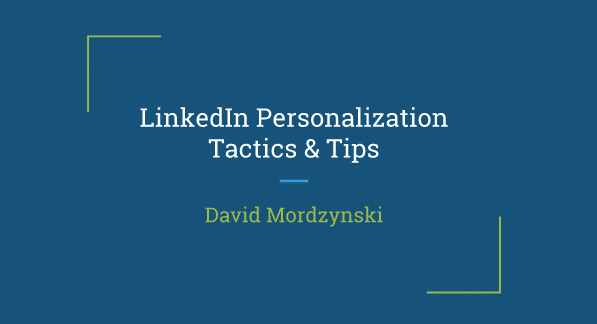How David Mordzynski Uses LinkedIn Profiles For Tailored Prospecting

For many, if not all, involved in sales prospecting it’s the eternal problem: do I send personalized emails to a select (aka relatively small) group of prospects or do I send a refined template to as many leads as possible?
It’s a tough one.
On the one hand, the more emails you send, the more chance you have at connecting with someone. On the other hand, if you send really personal emails to a small group of curated prospects, than those leads should be impressed with your research and respond more often.
Like most unanswerable questions, you can make a pretty convincing argument for both sides. But, after having dipped his toes in both realms, the answer for Demandbase’s David Mordzynski is clear – it’s the personal that works.
“I came from a world where it was basically a shark tank. Pick up the phone, make 80 calls a day, and send 80 emails a day. It was a volume game,” says Mordzynski, in a recent edition of The Predictable Revenue Podcast.
“Then, I came to a B2B company where we practiced account based marketing. It’s not about quantity, it’s all about quality. I quickly learned that just being busy doesn’t mean you had a good day. Your work has to turn into something. So, I took a step back. I started personalizing emails – it didn’t work at first, but I kept trying and kept developing the system.”
For example, if you went to the same school as a prospect, mention that in your subject line or as a “PS” line in your email. Or, if a prospect has a unique headline, use that exact language in your subject line.
“What you’re doing here is appealing to people’s brands,” says Mordzynski.
“People’s personal brands.”
As for mutual connections, Mordzynski advises to, of course, reach out to that mutual connection, but also to provide a lot of the language you want to see in the introductory email to help focus the subsequent conversations. In other words, do a lot of the work for the respective connection.
“Use your connections! Of course, ask your mutual friends that can bridge the connection,” says Mordzynski.
“But, give your friend all of the relevant information, and tell them what you want to speak about.”
Mordzynski admits his system will take more time than sending the same template to substantially more leads. But, as with any prospecting method, refining the process is key. For Mordzynski, refinement meant building half-finished templates for each LinkedIn element, with space left for the personal sentiments he adds.
“Looking at a profile, you can probably find something to say in under two minutes. For writing the email, because I have templates based around all of these options, I can write an email in two minutes. It was not easy at first, I’ve been using this system for over two years now,” says Mordzynski.
“One of the first times I tried to personalize an email, I was writing to someone who worked at Blackberry. I told them I loved playing Brickbreaker. That email took me 20 minutes to send. Now, it’s like a machine. I call it plug and play.”
For a detailed breakdown of David Mordzynski’s LinkedIn prospecting method, check out his edition of The Predictable Revenue Podcast.
NO TIME TO READ?
Listen On:
